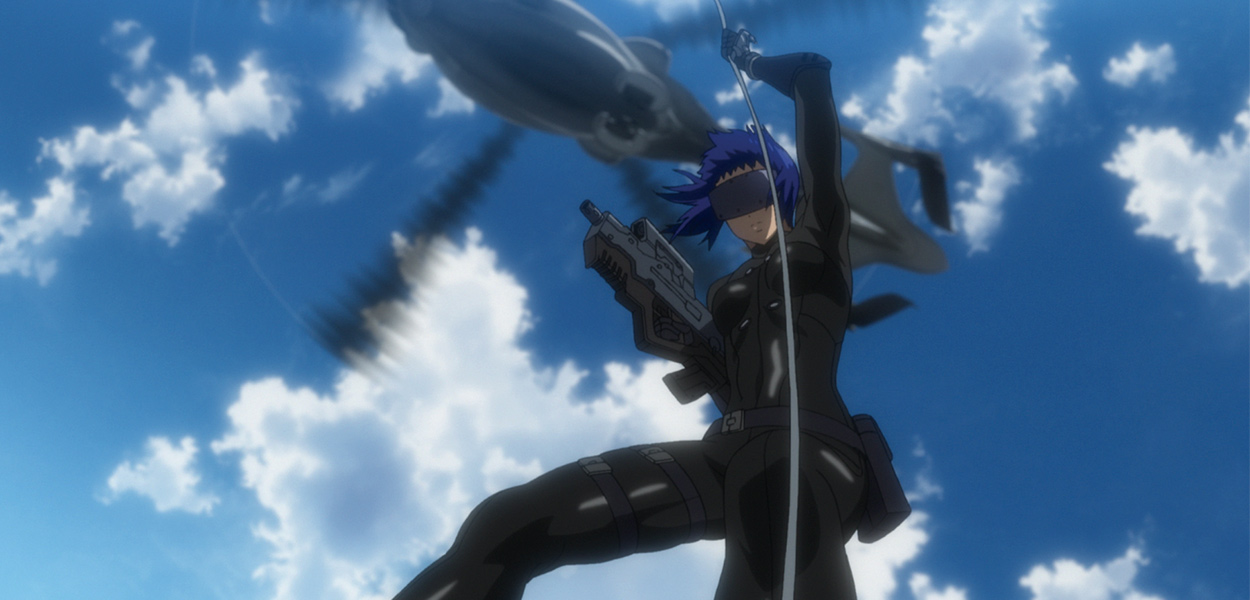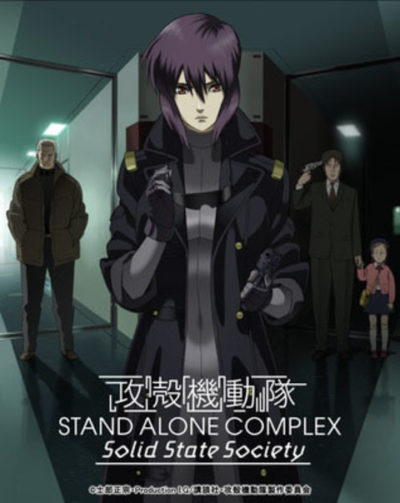 ★★★
★★★
“Majors in stunning visuals; minors in everything else.”
I really wanted to like this. Seriously, this had the potential to be thoroughly kick-ass, innovative and visually stunning, in a way never before seen in action heroine cinema. However, the end result is only somewhat kick-ass, and might have felt more innovative. if Ghost in the Shell hadn’t already been strip-mined for ideas over the past two decades, as noted over the weekend, by everyone from James Cameron to the Wachowskis. Rather than pushing the imagination envelope further, Sanders and the film’s script seems content to coast along on the original ideas, and these are no longer as cutting-edge as they need to be.
The story still concerns the Major (Johansson), here the marginal survivor of a terrorist attack, who has her brain transplanted into an entirely artificial body by the Hanka Robotics corporation. She has become the top operative of a government security group Section 9, working alongside somewhat-cyberized Batou (Asbæk) and the still entirely human Togusa, under the command of Aramaki (Kitano). Hanka becomes the target of a series of cyber-terrorist attacks, investigated by the Major, despite experiencing “glitches” of audio-visual hallucinations. The culprit is revealed to be a hacker known as Kuze (Pitt). Turns out he has more than a slight connection to the Major, being in possession of disturbing information about her origin, as well as her life before becoming a full-body cyborg.
 The story has a very clever approach to the whole “whitewashing” controversy: at least initially, rather than Motoko Kusanagi, she has been reinvented by Hanka Robotics as Mira Killian, who give her a whole new set of memories, which may or may not be accurate. It’s this quest for her real identity which drives the plot, containing more than a few echoes of Robocop. And that’s an illustration of the main problem here: it feels less like anything cutting edge, than a conglomeration of elements taken from films which has gone before. That half of these stole from the animated Ghost, doesn’t help the live-action version much.
The story has a very clever approach to the whole “whitewashing” controversy: at least initially, rather than Motoko Kusanagi, she has been reinvented by Hanka Robotics as Mira Killian, who give her a whole new set of memories, which may or may not be accurate. It’s this quest for her real identity which drives the plot, containing more than a few echoes of Robocop. And that’s an illustration of the main problem here: it feels less like anything cutting edge, than a conglomeration of elements taken from films which has gone before. That half of these stole from the animated Ghost, doesn’t help the live-action version much.
There are are some aspects which work. It looks lovely, and I can’t say I felt shortchanged by having gone to the cinema to see it: though even here, it’s like Blade Runner with less rain and more daylight. The cast are good too. Johansson has the correct deadpan approach, Asbæk is ideal for the hulking Batou and Kitano knocks it out of the park, as the most bad-ass bureaucrat you’ve ever seen [this will be absolutely no surprise if you’ve seen classic Kitano films such as Violent Cop]. However, in action, it only works in intermittent moments, such as the raid against the hacked geisha robots, or the battle against the spider-tank – the latter certainly lives up to expectations from the other versions.
The aspect which did work better than in the animation was the blurred line between humans and cyborgs, which is more striking when you have real people involved. There’s one scene, for instance, where Kuze is talking to the Major, and he simply reaches out and lifts a quarter-panel of her face off. It’s a startling image; truth be told, perhaps too startling, as I spent the rest of the scene thinking, “SCARLETT JOHANSSON IS MISSING PART OF HER HEAD!” rather than about the conversation between the two characters. I’ve also heard a number of people say this was a case where 3D genuinely improved the experience – we saw it in 2D, in deference to Chris’s motion sickness, which ended 3D viewing for us at Avatar.
At a brisk 106 minutes, it doesn’t hang around, though the story appears to shift gears at about the half-way point, and becomes more focused and driven. It’s still barely able to scratch the surface of the universe: having watched four movies, 52 TV episodes and four hour-long OVAs over the past couple of months, I was painfully aware of how much was going on that had to be utterly discarded here – yet they still found time to include a number of scenes e.g. the water fight, which felt inserted, purely as homages to the original material. Did appreciate the way languages were completely fluid: Aramaki spoke all his lines in Japanese, yet the Major was entirely in English, as if this was as much a stylistic choice as the shape of your “shell.”
Unfortunately, it looks like this will likely be one and done for the franchise, with the film being crushed at the North American box-office by – pardon me while I throw up – Baby Boss. If the makers are to recoup their investment, it will need to follow in the footsteps of Resident Evil: The Final Chapter, and perform well in overseas markets. [RE: TFC has now taken 11x as much in foreign markets as it did in the US/Canada] Action heroine fans will be hoping for better results on June 2, when Wonder Woman opens.
Dir: Rupert Sanders
Star: Scarlett Johansson, Michael Pitt, Pilou Asbæk, “Beat” Takeshi Kitano







 ★★★★
★★★★ Much more a reboot, complete with a redesigned lead, than any kind of sequel, this four-part series of hour-long episodes received a theatrical release in Japan, before being released on DVD. In a typically confusing GitS universe approach, it was then broadcast on TV in 10 episodes, with extra material added. I mention this only because it’s the four-part version which will be reviewed here. It starts before Major Kusanagi (Maxwell) joins up with her boss, Aramaki (Swasey): initially, she’s part of the 501st, a counter-cyberterrorism group which owns her cyborg body. However, Aramaki offers her the opportunity to go freelance under him, doing similar work, and assemble a team who will largely be free from bureaucratic oversight.
Much more a reboot, complete with a redesigned lead, than any kind of sequel, this four-part series of hour-long episodes received a theatrical release in Japan, before being released on DVD. In a typically confusing GitS universe approach, it was then broadcast on TV in 10 episodes, with extra material added. I mention this only because it’s the four-part version which will be reviewed here. It starts before Major Kusanagi (Maxwell) joins up with her boss, Aramaki (Swasey): initially, she’s part of the 501st, a counter-cyberterrorism group which owns her cyborg body. However, Aramaki offers her the opportunity to go freelance under him, doing similar work, and assemble a team who will largely be free from bureaucratic oversight. Over the course of the four episodes, she recruits others whose names will be familiar. For example, ex-Ranger Batou (Sabat), comes aboard after initially being part of a team working against Kusanagi, who are trying to prove government complicity in war crimes. This is an interesting change, compared to the previous versions, which always seemed to join Section 9 “in progress,” and provides some intriguing insight into what makes – literally, to some extent – the Major the way she is. For, in this incarnation, we discover that she has been in her prosthetic body since birth, and has never known any other way of life.
Over the course of the four episodes, she recruits others whose names will be familiar. For example, ex-Ranger Batou (Sabat), comes aboard after initially being part of a team working against Kusanagi, who are trying to prove government complicity in war crimes. This is an interesting change, compared to the previous versions, which always seemed to join Section 9 “in progress,” and provides some intriguing insight into what makes – literally, to some extent – the Major the way she is. For, in this incarnation, we discover that she has been in her prosthetic body since birth, and has never known any other way of life. This is largely included purely for completeness: if this had been a stand-alone film, it likely wouldn’t have qualified, not reaching the mandatory minimum quota of action heroineness. For in this sequel, Major Kusanagi (Tanaka) has abandoned even her artificial physical form, for life entirely inside the Internet. Her presence in this is therefore more spiritual, with Batou (Yamadera) referring to her as his “guardian angel”, and her impact is more felt than seen – particularly in its ramification for Batou, whose degree of cybernetic enhancement is not much lower than hers. She only returns to a tangible persona in the final scene, where Batou has to take on a near-endless stream of combat-reprogrammed sex robots. My, that’s a phrase I never thought I’d be writing…
This is largely included purely for completeness: if this had been a stand-alone film, it likely wouldn’t have qualified, not reaching the mandatory minimum quota of action heroineness. For in this sequel, Major Kusanagi (Tanaka) has abandoned even her artificial physical form, for life entirely inside the Internet. Her presence in this is therefore more spiritual, with Batou (Yamadera) referring to her as his “guardian angel”, and her impact is more felt than seen – particularly in its ramification for Batou, whose degree of cybernetic enhancement is not much lower than hers. She only returns to a tangible persona in the final scene, where Batou has to take on a near-endless stream of combat-reprogrammed sex robots. My, that’s a phrase I never thought I’d be writing… Despite the critical and commercial success of the original film, it took a while for anything further to emerge from the GitS universe. Over the seven years after the movie, the only adapted media to be released was a 1997 video-game. This hiatus came to an end in October 2002 when Stand Alone Complex took the air on Japanese satellite station SKY PerfecTV!. This was a 26-part series, each episode lasting 25 minutes, and was followed in 2004 by S.A.C. 2nd GIG, which had the same format. In turn, the first season was adapted into both a feature-length version, The Laughing Man, and two manga volumes, while the second was also edited down into a feature-length edition, Individual Eleven.
Despite the critical and commercial success of the original film, it took a while for anything further to emerge from the GitS universe. Over the seven years after the movie, the only adapted media to be released was a 1997 video-game. This hiatus came to an end in October 2002 when Stand Alone Complex took the air on Japanese satellite station SKY PerfecTV!. This was a 26-part series, each episode lasting 25 minutes, and was followed in 2004 by S.A.C. 2nd GIG, which had the same format. In turn, the first season was adapted into both a feature-length version, The Laughing Man, and two manga volumes, while the second was also edited down into a feature-length edition, Individual Eleven. While the feature focused directly on the Major and her quest for identity, the series also uses its greater freedom to become more of an ensemble piece. The Major is clearly still the leader and boss, with skills that surpass everyone else – they defer to her, and it’s entirely understandable. But over the course of these 52 episodes, the spotlight turns at one point onto just about everyone else, from her hulking second-in-command, former Army Ranger Batou, through to Togusa, the member of Section 9 who has undergone the least amount of cybernetic enhancement. This allows it to explore their history. For example, the (somewhat notorious, due to its graphic violence) “Jungle Cruise” episode, had Batou hunting down an ex-military colleague who has become a serial killer.
While the feature focused directly on the Major and her quest for identity, the series also uses its greater freedom to become more of an ensemble piece. The Major is clearly still the leader and boss, with skills that surpass everyone else – they defer to her, and it’s entirely understandable. But over the course of these 52 episodes, the spotlight turns at one point onto just about everyone else, from her hulking second-in-command, former Army Ranger Batou, through to Togusa, the member of Section 9 who has undergone the least amount of cybernetic enhancement. This allows it to explore their history. For example, the (somewhat notorious, due to its graphic violence) “Jungle Cruise” episode, had Batou hunting down an ex-military colleague who has become a serial killer. A rather clunky title for an OAV (original animation video), which came out in September 2006, about 18 months after the end of season two. It’s also two years after the events depicted, with Major Kusanagi (Tanaka) having quit her job as Section 9, and largely dropped off the grid. Batou (Ōtsuka) has taken over her position as S9’s top field operative, with Togusa (Yamadera) the. After a series of suicides exposes a plot for a bioterror attack, the group is on the hunt for a hacker called the Puppeteer, apparently behind it. But the investigation finds the apparent attack was almost a diversion, and uncovers a massive child abduction ring that may be responsible for as many as 20,000 kidnappings.
A rather clunky title for an OAV (original animation video), which came out in September 2006, about 18 months after the end of season two. It’s also two years after the events depicted, with Major Kusanagi (Tanaka) having quit her job as Section 9, and largely dropped off the grid. Batou (Ōtsuka) has taken over her position as S9’s top field operative, with Togusa (Yamadera) the. After a series of suicides exposes a plot for a bioterror attack, the group is on the hunt for a hacker called the Puppeteer, apparently behind it. But the investigation finds the apparent attack was almost a diversion, and uncovers a massive child abduction ring that may be responsible for as many as 20,000 kidnappings. Renowned for its influence on just about every subsequent cyberpunk entity, from The Matrix to Westworld, this also remains one of the classic anime movies, more than two decades after its release. The main problem though, is the translation of a densely-packed and heavily notated manga series by Masamune Shirow, into an 82-minute action feature. You’re left with something forced to cram the philosophical aspects into a couple of indigestible lumps – an approach certainly also adopted by the Wachowski Brothers.
Renowned for its influence on just about every subsequent cyberpunk entity, from The Matrix to Westworld, this also remains one of the classic anime movies, more than two decades after its release. The main problem though, is the translation of a densely-packed and heavily notated manga series by Masamune Shirow, into an 82-minute action feature. You’re left with something forced to cram the philosophical aspects into a couple of indigestible lumps – an approach certainly also adopted by the Wachowski Brothers. I initially thought I had a fairly good handle on where the first book in the Immortal Vegas series (currently at six entries, plus a prequel) was going, with a Lara Croft-esque lead, who specializes in locating and recovering ancient artifacts. You can also throw in fragments of The Da Vinci Code, since she is hired to retrieve a relic from the secret basement beneath the Vatican, and is going up against a cult of religious, Catholic fanatics. But it somehow ends up taking a sharp right-turn, ending up in a version of Las Vegas where, just out of phase with the casinos and hotels, lurks a hidden dimension of other venues, populated by…
I initially thought I had a fairly good handle on where the first book in the Immortal Vegas series (currently at six entries, plus a prequel) was going, with a Lara Croft-esque lead, who specializes in locating and recovering ancient artifacts. You can also throw in fragments of The Da Vinci Code, since she is hired to retrieve a relic from the secret basement beneath the Vatican, and is going up against a cult of religious, Catholic fanatics. But it somehow ends up taking a sharp right-turn, ending up in a version of Las Vegas where, just out of phase with the casinos and hotels, lurks a hidden dimension of other venues, populated by… If this seems somewhat familiar, it’s because it is not dissimilar to
If this seems somewhat familiar, it’s because it is not dissimilar to  If you want something more cerebral and family friendly than
If you want something more cerebral and family friendly than  This works rather better as historical fiction than an action novel, and is set in the late 15th century, when the province of Brittany was fighting to remain independent from France. Such high-level political machinations are far above the heads of most inhabitants, who are busy with everyday survival. At the beginning of the book, this includes the heroine, 17-year-old Ismae, who is more concerned about her upcoming, unwanted marriage – more of a sale by her father, to be honest – to a brutal husband. Rescue comes in an unexpected form, as she is whisked away to the Convent of St. Mortain, devoted to one of the pagan gods, absorbed into the Catholic faith as a saint. Mortain’s field is death, and Ismae, who has a natural immunity to poison, is trained in his dark arts. She becomes a tool used by the Mother Superior – albeit for political ends as much as religious ones.
This works rather better as historical fiction than an action novel, and is set in the late 15th century, when the province of Brittany was fighting to remain independent from France. Such high-level political machinations are far above the heads of most inhabitants, who are busy with everyday survival. At the beginning of the book, this includes the heroine, 17-year-old Ismae, who is more concerned about her upcoming, unwanted marriage – more of a sale by her father, to be honest – to a brutal husband. Rescue comes in an unexpected form, as she is whisked away to the Convent of St. Mortain, devoted to one of the pagan gods, absorbed into the Catholic faith as a saint. Mortain’s field is death, and Ismae, who has a natural immunity to poison, is trained in his dark arts. She becomes a tool used by the Mother Superior – albeit for political ends as much as religious ones.